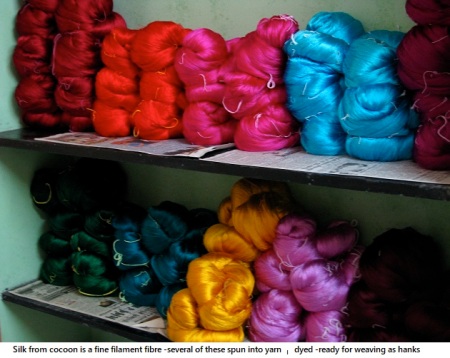Post 368 –by Gautam Shah
.
A fibre is a flexible linear entity with very small section compared to its length. Fibres are of natural plant or animal origin, or synthetic products. Fibres are used for spinning into yarn, forming threads and ropes. Yarns are used for weaving or knitting into fabrics. Fibres of plant origin, like cotton is pure cellulose and used for production of paper and other cellulosic compounds. Fibres are massed (without any weaving) to form padding materials, filter media, blankets and mattresses. Fibres and their products are also used as reinforcements and as the fillers in formation of composites.

Polyester Texturized Yarn
A fiber is characterized by its length which is as much as 100 times its diameter or width (10 µm -width of cotton fibre). Fibres do not have consistent section along its length. Fibres of natural origin (and synthetic fibres that has been cut) are short, called staples, whereas silk and synthetics are long length fibres, called filaments. To spin fibres into a yarn, the lengths should be minimum 5 mm. A typical yarn could have more than 30 fibres. To spin a yarn fibres must have flexibility, texture, cohesiveness, elasticity, fineness, uniformity, durability, luster and sufficient strength for spin-twisting. A variable cross section gives (longitudinal structural elements -fibrils) textural effect to the fabric. Fibres that cannot be split longitudinally are called elementary, and when several such elementary fibres join longitudinally to form conjugated fibres. The length of the fiber affects the appearance of the yarn and the quality of the fabric. It is easy to produce a smooth yarn from a filament compared to staples, which require greater amount of the twist. Yarns made from the filament have greater luster, but yarns made from staple fibres have a dull appearance.

Cotton fibre under scanner
The quality of a fabric is largely related to the physical characteristics of the fiber such as:
Colour: Colour of the natural fibres varies; however darker shades can be lightened by bleaching and than a uniform colour can be applied.
Luster: Luster is the amount of light reflected by the fiber. It is both a desirable and undesirable property, depending on the type of use-conditions. Man-made fibres generally have a high luster, which can be reduced or de-lustered by incorporating titanium dioxide in the manufacturing process.

Shape: Shape relates to the shape of the cross section of the fiber. In case of man-made fibres, it is very uniform (unless further processed by ‘texturizing’) over the length, compared to a variable cross section of natural fibres. Cross sectional shape affects the appearance, feel, surface texture, body, covering power and luster. Round sectional fibres have soft, smooth and slippery feel, high luster, poor covering, and close packing. Dog bone shaped and flat section fibres have a harsher, less smooth handle, good covering and high luster (except cotton). Fibres with multiple lobes in cross section have high covering power, silk like feel, high luster and sometimes soft subdued sheen. Hollow fibres are made by dissolving the inner core material and have high bulk but low weight, fluffy. Such fibres are insulative and absorbent.

Hand spun llama yarn
Surface contour: Surface contour of the fiber in length is smooth, rough or uneven. Wool is covered with small scales that make the fiber cling together, cotton has twisted surface, that reflects the light unevenly and imparts a dull appearance. Manufacturing characteristics and irregularities appear on man-made fibres.

Magnified fibers of (a) silk (b) wool (c) cotton
Crimp: Crimp is an undulating physical structure. Wool has a natural three-dimensional crimp. Most man made fibres are either produced with a crimp or texturized. Fabrics produced from crimped fibres have increased bulk, cohesiveness, warmth, false absorption and better resiliency.
.jpg)
Jute
Types of Fibres and Yarns: Fibres are spun into yarn. Yarns are uninterrupted threads of textile fibres that are ready to be turned into fabrics. Natural fibres originating from natural sources are: Plant (cellulosic), animal (protein). Manufactured, synthetic, or man-made fibres originate from chemical sources or could also be from regenerated or recycled sources.

Aramid Fibers
.
Pingback: BLOG LINKS on CURTAINS and SOFT FURNISHINGS | Interior Design Assist